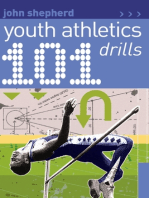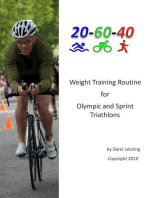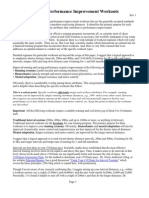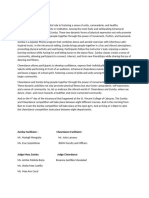Soccer Referee Fitness
Soccer Referee Fitness
Uploaded by
Doarvoas ClaudiuCopyright:
Available Formats
Soccer Referee Fitness
Soccer Referee Fitness
Uploaded by
Doarvoas ClaudiuCopyright
Available Formats
Share this document
Did you find this document useful?
Is this content inappropriate?
Copyright:
Available Formats
Soccer Referee Fitness
Soccer Referee Fitness
Uploaded by
Doarvoas ClaudiuCopyright:
Available Formats
Soccer Referee Fitness Training
Larry Gardner
B.S. PES, CPT, SFS
All referees agree that conditioning work is a must for year round training. What they don't agree on is how to perform the conditioning. Conditioning should not be referred to as just aerobic training. Soccer refereeing requires speed and power and if you are running mileage, I truly feel bad that it is counterproductive. You are putting yourself at a severe disadvantage and are actually hurting your performance. What types of conditioning should you do? I continually stress the importance of general strength circuits for the average soccer referee. You can work on multiple facets while performing GS circuits. You are working on strengthening, balance, coordination, and aerobic capacity. I recommend that you use this as a recovery day type of workout. These workouts are especially great when you are just starting your conditioning program. General strength circuit training helps you to build a greater work capacity, something that referees need that are just getting into soccer refereeing conditioning program. Example of a General Strength workout: Here is an example of a general strength circuit performed on the pitch; Split squats - 10 each leg Jog 50 yards Rotational push-ups - 8 each Jog 50 yards Bicycles - 1x30 Jog 50 yards Burpees - 1x10 Jog 50 yards Staggered push-ups - 10 each Jog 50 yards Russian twists - 1x25 Jog 50 yards Backwards lunges - 10-each leg Jog 50 yards Lateral lunges - 10 each leg Jog 50 yards Reverse crunches - 1x20 Jog 50 yards 1 Leg squats - 10 each leg Rest 3 minutes and repeat circuit.
Tempo Running Extensive Tempo are runs at 65-79% intensity (HR ~140-160). I typically use these runs at 100-600m. The length of these runs is going to depend on your present fitness level. For the most part, I do not use Extensive tempo runs too often. The old saying 'train slow to run slow' could be used here. A problem with extensive tempo is that you can't work on your running form at all with such slow speeds. The demands of soccer do not require referees to run far distances at slow speeds. The benefit of using extensive tempo runs are they can be used to help flush out the system. If you are feeling tired from previous workouts or even sore, extensive tempo workouts are great for recovery. Use extensive runs at the beginning of training sometimes to build a little base before jumping into intensive tempo workouts. Also this type of workout helps to enhance oxidative mechanisms. Use extensive tempo with our general strength circuits for the most part. This is where you run from station to station exercise. Examples of an Extensive Tempo Workout: 1) 2 x 10 x 100m (75% intensity) 30" rest between reps and 2' between sets 2) 2 x 8 x 200m (70% intensity) 1' rest between reps and 2' between sets Remember, referees should be able to hit their times and be within their target heart rate. If you aren't, take more rest between reps, reduce the volume of the workout or shut the workout down because you are missing the training benefit/goal. Intensive Tempo Intensive tempo is usually referred to as interval training. Intensive tempo is running distances over 80 meters at 80-89% intensity. (HR ~160-180). Running intervals for tempo work is also great for conditioning and superior to running long distances. Because intensive tempo borders on speed and special endurance due to the high intensity, lactate levels can become very high. Your body must adapt to handle, buffer and remove the lactate so training in this state is extremely helpful for soccer refereeing. Since all energy systems more or less turn on at the same time, intensive tempo is highly stressful on both the aerobic and anaerobic systems. It is a great conditioning tool used for soccer officiating.
Examples of an Intensive Tempo Workout: 1) 6 x 200m (82% intensity) 3.5' recovery between reps 2) 2 x 4 x 250m (86% intensity) 4' rest between reps and 8' rest between sets Progress the intensity of your tempo runs based on your conditioning goals. The ability of referees to buffer lactate accumulation will determine their success as fatigue levels rise throughout the course of their game.. Speed Endurance Speed endurance is the ability to maintain speed in the presence of fatigue without decelerating. Speed endurance runs are going to vary in distance depending on your fitness level. For example, soccer refereeing consists of short bursts of acceleration followed by lower intensity movements. So speed endurance workouts would be of shorter distances with shorter recovery. For a greater chance of success, try to maintain high levels of speed and intensity, even when tired. These workouts are mentally challenging (since the presence of fatigue), so maintaining proper form and technique must be stressed. Training at high levels while fatigued will help to improve performance, both mentally and physically at the end of the game when the game could be on the line.
Examples of a Speed Endurance Workout: 1) 2 sets of 7 x 30 yards 25 seconds rest between reps and 3 minutes between sets 2) 2 x 80y 95-100% intensity) 7 minutes rest 2 x 100y (95-100% intensity) 8-10 minutes rest 2 x 120y (90% intensity) 10 minutes rest How it relates to your fitness training: Monday: General Strength Circuits Tuesday: Acceleration Wednesday: Extensive Tempo Thursday - Acceleration Friday: General Strength Circuits
Next 2 weeks Monday: Acceleration Tuesday: GS Circuits Wednesday: Maximum Velocity Thursday: GS Circuits Friday: Acceleration Saturday: Intensive Tempo Depending on your improvements and progressions: Next 2 weeks Monday: Maximum Velocity Tuesday: GS Circuits Wednesday: Acceleration Thursday: GS Circuits Friday: Maximum Velocity Saturday: Intensive tempo Your training days will look like this at the end of the training period: Monday: Maximum Velocity (w/ Acceleration) Tuesday: GS circuits Wednesday: Speed Endurance Thursday: Extensive tempo Friday: Maximum Velocity (w /Acceleration) Saturday: Intensive tempo
You might also like
- MalmoDocument7 pagesMalmoKLC12345No ratings yet
- Adam BighillDocument3 pagesAdam BighillSanti SicaNo ratings yet
- Nike Soccer Week1Document3 pagesNike Soccer Week1Matthew CittaNo ratings yet
- Werner Günthör-ProgramDocument4 pagesWerner Günthör-Programdeadboy25100% (1)
- Kboges Workout Routine Easy Version For Me: Straight Bar DipDocument3 pagesKboges Workout Routine Easy Version For Me: Straight Bar Dipgreg hofmanNo ratings yet
- KIN 585 - Coaching Manual - Programming and Periodization For Collegiate BasketballDocument28 pagesKIN 585 - Coaching Manual - Programming and Periodization For Collegiate BasketballAaron Chew100% (3)
- Beep Test TrainingDocument31 pagesBeep Test TrainingMax100% (1)
- 12 Week Training ProgramDocument3 pages12 Week Training ProgramUb GraduatestudiesNo ratings yet
- Tarasov Anatoly Vladimirovich Khokkey Bez TaynDocument274 pagesTarasov Anatoly Vladimirovich Khokkey Bez Taynbushcraftru67% (3)
- Heart Monitor Training For The Compleat IdiotDocument5 pagesHeart Monitor Training For The Compleat IdiotRaja WajahatNo ratings yet
- Howtoskatea 10 KDocument62 pagesHowtoskatea 10 KIvar BrinkmanNo ratings yet
- The Next Level: by Hunter AllenDocument5 pagesThe Next Level: by Hunter AllenrlulioNo ratings yet
- Dyno Training GuideDocument38 pagesDyno Training GuideJustina ChungNo ratings yet
- The Things We Know and Do Not Say: The Future of Our CareerFrom EverandThe Things We Know and Do Not Say: The Future of Our CareerNo ratings yet
- ExplosiveIntervals, BillatDocument4 pagesExplosiveIntervals, Billatdf2medNo ratings yet
- High Performance Sport Skill Instruction, Training, and Coaching. 9 Powerful Principles for Athletes to Flow and Get in the ZoneFrom EverandHigh Performance Sport Skill Instruction, Training, and Coaching. 9 Powerful Principles for Athletes to Flow and Get in the ZoneNo ratings yet
- Five Rules For Chaos - Fergus ConnollyDocument19 pagesFive Rules For Chaos - Fergus ConnollyFergus Connolly100% (1)
- Vladimir Issurin Block Periodisation PDFDocument41 pagesVladimir Issurin Block Periodisation PDFferrosoNo ratings yet
- Golf Academy Price ListDocument2 pagesGolf Academy Price Listapi-249295137No ratings yet
- Total Heart Rate Training Customize and Maximize 1569755620Document4 pagesTotal Heart Rate Training Customize and Maximize 1569755620Arun Kumar KvNo ratings yet
- New vVO2max Workouts Lead To Impressive Gains in FitnessDocument6 pagesNew vVO2max Workouts Lead To Impressive Gains in FitnessSekulovski MarkoNo ratings yet
- The 25 Golden Rules of RunningDocument10 pagesThe 25 Golden Rules of RunningvivektonapiNo ratings yet
- USTA Dynamic Warm UpDocument12 pagesUSTA Dynamic Warm UpNirav PatelNo ratings yet
- Spartan Scoring DrillsDocument10 pagesSpartan Scoring Drillstony_alfonsoNo ratings yet
- 2012 Summer Workouts - Men'sDocument10 pages2012 Summer Workouts - Men'sJ Elias StokesNo ratings yet
- Short Sprint Interval TrainingDocument4 pagesShort Sprint Interval TrainingkarzinomNo ratings yet
- Athletics Weekly - January 23 2020Document66 pagesAthletics Weekly - January 23 2020FO VC100% (1)
- Superman WorkoutDocument3 pagesSuperman Workoutbrucemartin3No ratings yet
- Maybe You Need a More Dynamic System: Coaching High School BasketballFrom EverandMaybe You Need a More Dynamic System: Coaching High School BasketballNo ratings yet
- H El Guerrouj El Guerrouj's Training 1999Document4 pagesH El Guerrouj El Guerrouj's Training 1999Demetrio Frattarelli100% (1)
- The Ultimate Upper Body Workout: 7 Day Complete Upper Body Workout for Fast Muscle Growth & StrengthFrom EverandThe Ultimate Upper Body Workout: 7 Day Complete Upper Body Workout for Fast Muscle Growth & StrengthNo ratings yet
- Think Outside the Basket: A Guide for Tennis Parents: Collection of Exercises to Help Your Child On the Tennis CourtFrom EverandThink Outside the Basket: A Guide for Tennis Parents: Collection of Exercises to Help Your Child On the Tennis CourtNo ratings yet
- The 3RM Fighter Pullup ProgramDocument2 pagesThe 3RM Fighter Pullup Programtweetybyrd443013No ratings yet
- Strength and Hypertrophy with Calisthenics for BeginnersFrom EverandStrength and Hypertrophy with Calisthenics for BeginnersNo ratings yet
- Tline Pitcing Program PDFDocument6 pagesTline Pitcing Program PDFKolekade-Mattandkira AckerNo ratings yet
- Strong Bodies, Strong Business: A Step-By-Step Guide to Building a Sustainable Business Through WeightliftingFrom EverandStrong Bodies, Strong Business: A Step-By-Step Guide to Building a Sustainable Business Through WeightliftingNo ratings yet
- You (Only Faster) - Training Plans To Help You Train Smarter and Run Faster (PDFDrive)Document265 pagesYou (Only Faster) - Training Plans To Help You Train Smarter and Run Faster (PDFDrive)Nuno Roberto100% (1)
- Carl Runk's Coaching Lacrosse: Strategies, Drills, & Plays from an NCAA Tournament Winning Coach's PlaybookFrom EverandCarl Runk's Coaching Lacrosse: Strategies, Drills, & Plays from an NCAA Tournament Winning Coach's PlaybookNo ratings yet
- Management Conflict in Nursing WorkplacesDocument44 pagesManagement Conflict in Nursing WorkplacesMycactus100% (1)
- Middle Distance RunningDocument2 pagesMiddle Distance RunningKevin VillanuevaNo ratings yet
- 2017 Itccca ClinicDocument40 pages2017 Itccca ClinicTony JonesNo ratings yet
- Secrets of The Pros ExposedDocument38 pagesSecrets of The Pros ExposedTitus Baldwin100% (2)
- GJ NutritionDocument8 pagesGJ NutritionAnonymous NO0urGNo ratings yet
- Eight Sled Drag Variations For Strength and AthleticismDocument4 pagesEight Sled Drag Variations For Strength and AthleticismKyle CarterNo ratings yet
- Improve Vertical Jump - A Beginner's GuideDocument1 pageImprove Vertical Jump - A Beginner's GuideJoelNo ratings yet
- 7 Elements of A Successful Speed ProgramDocument9 pages7 Elements of A Successful Speed ProgramDoubles StandardNo ratings yet
- Swish: The Quest for Basketball's Perfect ShotFrom EverandSwish: The Quest for Basketball's Perfect ShotRating: 3 out of 5 stars3/5 (1)
- The Fabulous 15 Exercises For A Better Vertical PDFDocument5 pagesThe Fabulous 15 Exercises For A Better Vertical PDFKeijoNo ratings yet
- Get Fit To Apply RMDocument1 pageGet Fit To Apply RMGlobalStrategyNo ratings yet
- RunningDocument6 pagesRunningzenview2000No ratings yet
- Shared Rondel The Total SpecialstDocument266 pagesShared Rondel The Total SpecialstUggleklockanNo ratings yet
- Passionate Niches1800Document72 pagesPassionate Niches1800mohamedNo ratings yet
- Physical FitnessDocument61 pagesPhysical FitnessJradz Tolentino40% (5)
- Quizez in Physical FitDocument4 pagesQuizez in Physical FitBusran Salamah TNo ratings yet
- Worksheet 4: Lifestyle Physical Activity and Positive AttitudesDocument23 pagesWorksheet 4: Lifestyle Physical Activity and Positive AttitudesShalee Carpio BalanquitNo ratings yet
- Step Into Life Berwick Fresh Air March 2013Document14 pagesStep Into Life Berwick Fresh Air March 2013Marko RadisicNo ratings yet
- Fitness Record SheetDocument1 pageFitness Record SheetMIGUEL JOSHUA VILLANUEVANo ratings yet
- 5 - 3 - 1 BBB Beefcake & BTMDocument24 pages5 - 3 - 1 BBB Beefcake & BTMGeniální MajsterNo ratings yet
- Zumba OfficialDocument28 pagesZumba Officialjerrycasaul0502No ratings yet
- Training and Testing Physical Capacities For Elite Soccer PlayersDocument10 pagesTraining and Testing Physical Capacities For Elite Soccer Playersapi-237441903No ratings yet
- Pe Lesson 1 2Document4 pagesPe Lesson 1 2mariel salalilaNo ratings yet
- Thick & FullDocument12 pagesThick & FullandykinhungNo ratings yet
- Z Scores BoysDocument7 pagesZ Scores BoysJames Karl HugoNo ratings yet
- BHHDocument3 pagesBHHfreddiet3No ratings yet
- 101 Fitness DrillsDocument83 pages101 Fitness DrillsRoisin50% (2)
- O41S BW WorkoutDocument37 pagesO41S BW WorkoutPaulo AlmacenNo ratings yet
- How To Build Your Own Workout Routine Nerd FitnessDocument13 pagesHow To Build Your Own Workout Routine Nerd Fitnessdoc mo100% (1)
- Brick Training Method PowerpointDocument47 pagesBrick Training Method PowerpointZac Brouillette100% (10)
- Beginners Workout Program IntroductionDocument8 pagesBeginners Workout Program IntroductionKishor Rathod0% (1)
- Hector 28 Ago 2023Document1 pageHector 28 Ago 2023Héctor Pérez RivasNo ratings yet
- Chapter 11 ModifiedDocument36 pagesChapter 11 ModifiedRyan-Jay AbolenciaNo ratings yet
- Lesson 2 Pe 101Document6 pagesLesson 2 Pe 101Chloe RosalesNo ratings yet
- Power of Strength Training For Older AdultsDocument6 pagesPower of Strength Training For Older Adultsvazrak100% (1)
- CompTrain 20 Rep Strength CycleDocument6 pagesCompTrain 20 Rep Strength CycleGastón GarciaNo ratings yet
- Metabolic Equivalents (METS) in Exercise Testing, Exercise Prescription and Evaluation of Functional CapacityDocument11 pagesMetabolic Equivalents (METS) in Exercise Testing, Exercise Prescription and Evaluation of Functional CapacityEva Rocío MartínezNo ratings yet
- The Fittest: Survival ofDocument1 pageThe Fittest: Survival ofapi-224336109No ratings yet
- Week 1 Workout: Total Body Workout ADocument4 pagesWeek 1 Workout: Total Body Workout ASam100% (3)

























































































